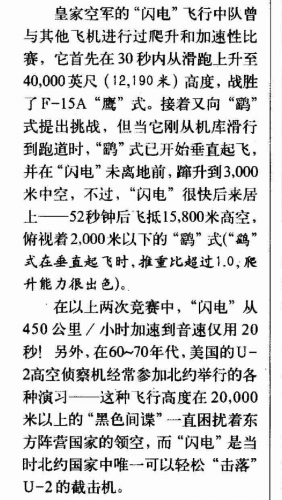30 seconds from runway to 40,000 ft when competing with a F-15A.
Mach 1.4 vertical? I find that more than a bit difficult to believe.
Translation:
RAF Lightning Squadron was once in a climbing and acceleration race with other aircraft. At first it climbed to an altitude of 40,000 ft (12,190 m) from taxiing within 30 seconds, defeating the F-15A "Eagle". Then it was going to challenge the Harrier but when the Lightning was still taxiing from the hangar to the runway, the Harrier had vertically taken off and climbed to an altitude of 3,000 m before the Lightning could take off. However, the Lightning soon caught up - reaching an altitude of 15,800 m after 52 seconds - and overlooked the Harrier 2,000 m below. (The Harrier got an excellent climbing performance and had a thrust-to-weight ratio over 1.0 when vertically taking off.)
In these two competitions, Lightning accelerated from 450 kph to sound speed with 20 seconds! Besides, in 1960s-1970s, the American U-2 high altitude reconnaissance aircraft often took part in various NATO exercises. This kind of "Black Spy" with a cruising altitude of 20,000 m always beset the airspace of eastern countries, and Lightning was the only interceptor in NATO that could easily "shoot down" the U-2.
source:"陈朴.十大生不逢时战机之四 明亮而无声的闪电[J].航空史研究,2001(07):25-29+50-52. "
(Author Name: Chen Pu. Article Name: The Fourth of The Ten Warplane Being Born at A Wrong Time - Bright But Silent Lightning. Journal Name: Aviation History Research. Time: 2001(07). Page: 25-29, 50-52.)


